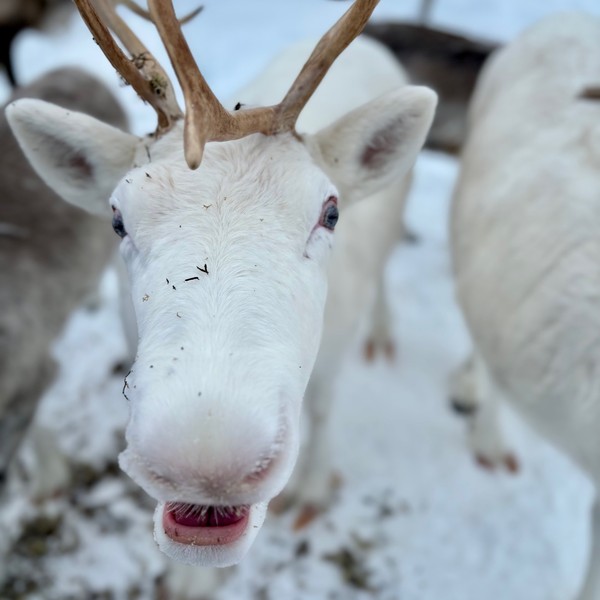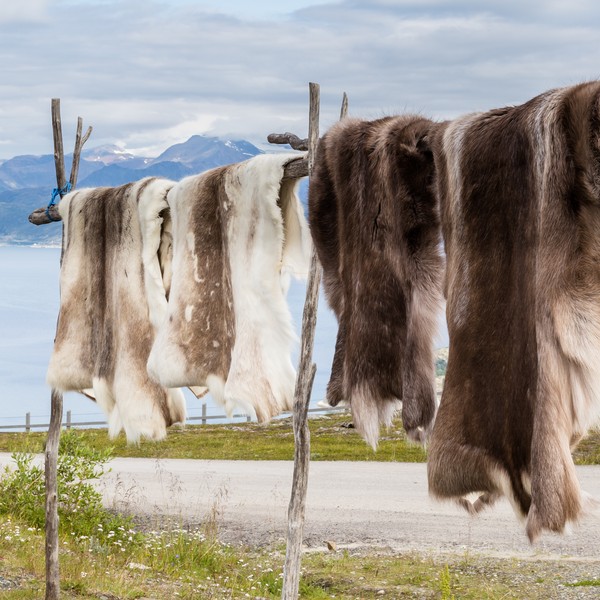Reindeer antler, more than just a horn, a story to tell
Reindeer are animals that live mainly in northern regions of the globe in vast forests. Every year, they lose their antlers after the rutting season, and it's time for nature lovers to roam the meadows and forests in search of fallen antlers.
In this article, I'll introduce you to reindeer antlers and explain why they're not horns!

Anne-Laure Compain



What's the difference between reindeer antlers and reindeer horn?
Reindeer don't have horns; they have antlers that fall off each winter and grow back each spring.
- The antlers are made of bone, are branched and fall off every year.
- Example: reindeer antler with several branches (or branches, to put it simply).
- Horns are permanent, unbranched and made of bone and keratin (the same substance found in our hair and nails).
- Example: unbranched goat's horn, with only one part.
The reindeer, a majestic mammal
Reindeer live in the northern regions of the globe in forests and large meadows. Here are the regions of the globe where reindeer can be found:
- Finland
- Norway
- Canada
- Greenland
- Mongolia
- United States
- Russia

Map of reindeer/caribou distribution worldwide.
Introducing the reindeer
The reindeer is a robust animal made to live in extremely cold conditions. | |
Reindeer have dense coats and a layer of subcutaneous fat that helps them retain heat. Also, their snout is designed in such a way that when they inhale cold air, the snout will warm it up before it reaches the lungs. This minimizes cooling. | |
Reindeer are herbivores, eating mainly lichen, moss, mushrooms and grass. In winter, they can dig into the snow with their antlers to find food buried under a thick layer of snow. | |
Reindeer migrate seasonally, in search of food and to breed. They can migrate great distances, covering hundreds of kilometers every year. |
What's the difference between reindeer and caribou?
Physically, there's no difference between reindeer and caribou! It's just a matter of naming the animal in different parts of the world. Wild reindeer living in Canada and the northern United States are called "caribou". When a reindeer lives in other parts of the world, or is domesticated, we call it "reindeer"!
The domesticated reindeer
It is estimated that the first domesticated reindeer lived in the Arctic regions around 3,000 years ago.
Over the years, reindeer domestication has spread to many parts of the globe, including Siberia, Scandinavia and Alaska. These are regions inhabited by indigenous peoples who have depended heavily on reindeer for many years.
But why did these peoples domesticate reindeer? Quite simply for survival. The reindeer is an animal that provides food (meat and milk), warmth, clothing (skin) and essential building materials (leather and bone) for survival in these hostile climates.



If these peoples have chosen to domesticate this majestic animal, it's because reindeer bring many advantages to these inhospitable environments. The first being food security, but that's not all. Reindeer were and still are used by indigenous peoples to transport goods and people. This enables them to move with the seasons and follow the migration of the reindeer herds.
Today, reindeer domestication is still very common in Siberia and Scandinavia. Take Finland, for example: Lapland is home to the Sami, an indigenous people whose main source of income is reindeer herding. Reindeer husbandry is carried out in semi-liberty, as before, preserving the cultural heritage and maintaining a real connection between the animal and nature.
Reindeer herding enables the Sami to make a living from tourism, producing meat and leather, and selling reindeer antlers and hides.
How are reindeer antlers formed?
Antlers are bony structures that grow on the skulls of reindeer every year. Antlers are very strong and can grow to very large sizes. Unlike other cervids, female reindeer also have antlers, but they are much smaller in size. Male antlers can reach 1.30 m, while female antlers reach a maximum size of 50 cm.
For a female reindeer, antlers are used to defend her territory against other females or to find food. But when times are hard or food is scarce, females prefer to conserve their energy for more vital functions, and don't produce antlers.
You might think that the antlers only grow for aesthetic reasons, but, as with many things in nature, they have a real function for the animal. These velvet-covered antlers play a vital role in the survival and reproduction of these animals.
Reindeer antlers grow very quickly, thanks to the many nutrients and oxygen they contain. Antlers can grow up to 1 cm per day.
Reindeer antlers begin to grow in spring, then expand in summer. At first, only two small bumps can be seen on the top of the reindeer's skull.
By autumn, they have reached their maximum size and strength. This is also when the velvet starts to come off the antlers.
Why do reindeer antlers look like velvet?
Is there velvet on reindeer antler? Yes, there is!
As the antlers grow, a fabric covers them to protect them and ensure blood circulation. This velvet is rich in blood vessels and nerves. It ensures blood circulation in the bone for optimal growth.

At the end of growth, when the bone is fully developed, the velvet on the antlers dries out and falls off. Reindeer will then do their utmost to remove all the velvet from their antlers. There's only one thing to do: rub the antlers against the tree trunks!
Soak up the essence of Finnish craftsmanship as you explore the history and manufacture of this traditional mug and Finnish traditions. By subscribing, you'll receive weekly updates on kuksa.
What are reindeer antlers used for?
First of all, antler growth on a male reindeer is only possible if the animal is strong and healthy. The reindeer's health, age and, above all, diet are important factors in annual antler growth. Antler size can vary from year to year. The older the reindeer, the bigger the antlers. Indeed, for a young male, all his energy will be concentrated on growing his body, not his antlers.
To reproduce
Antler appearance is a real social status for reindeer! A male with big, strong antlers is a male that females should mate with, as it's a sign that he's strong and healthy.
Some males will even carry foliage in their antlers to give the impression that their antlers are bigger!
Males use their antlers during the breeding season (between September and October) to impress females, but also to fight other male reindeer to establish dominance and win the right to breed.

Once mated, antlers are of no further use to the reindeer. Since antlers consume a great deal of energy - the energy needed to survive the winter - they fall off quickly after the rut.
To feed yourself
Reindeer also use their antlers to drop fruit from trees, or to dig holes in the ground or snow for roots.
To defend yourself
Against attacks from predators such as wolves or bears, antlers can be very useful. They can be used to repel, wound or deliver powerful, even lethal blows.
When do reindeer lose their antlers?
There are several factors that can cause a reindeer to lose its antlers:
- When fighting another reindeer
- In case of poor nutrition or health
- Naturally after the rutting season
As mentioned above, the first sign is the loss of velvet. This moult is due to a drop in testosterone levels. Once moulting has begun, antler loss occurs rapidly, between 2 days and 2 weeks.
Reindeer shed their antlers between January and March. But the further north an animal lives, the earlier it sheds its antlers.

Reindeer antlers and handicrafts
In many northern indigenous societies, the people have a deep and respectful relationship with the reindeer. The antlers shed by the reindeer each year enable them to create objects for their daily lives, but also for sale, and thus help their villages prosper.
Many reindeer herders, as in Finnish Lapland, open their doors to tourists and introduce them to their trade. Tourists can discover a reindeer farm, meet the local people, eat local food and, above all, buy reindeer hides or objects made from reindeer antlers.
Reindeer antlers are therefore used to manufacture a wide range of products such as :
- Traditional objects of art
- Knives
- Jewelry
- Musical instruments
- Buttons on clothes
Reindeer antler is a highly versatile, natural and sustainable raw material.
In our boutique, we offer kuksa decorated with reindeer antlers, handmade in Finnish Lapland.


The importance of reindeer preservation
Today, reindeer and caribou are under increasing threat, and their numbers are declining year by year.
Their habitat is increasingly reduced in certain regions due to human actions or the installation of industries. These human impacts reduce food availability and disrupt reindeer migrations, exposing them to starvation and stress.
Global warming, which is affecting Arctic ecosystems, is altering the migration patterns of the herds, exposing them either to new predators or even harsher climatic conditions.
Unfortunately, it's not just that, there's also the excessive hunting of wild reindeer and the ever-increasing number of accidents between cars and reindeer. During their migration, reindeer cross many countries, towns and roads that are becoming increasingly populated


Unique wooden mugs for unforgettable moments
Start shopping now 🌿
Come and discover our wooden tableware from Finland. Handmade tableware that will accompany young and old alike for years to come!
Would you like to find out more about Finland and its crafts?
If you like Finland, then these articles should interest you too.

Anne-Laure Compain

Anne-Laure Compain

Anne-Laure Compain
Subscribe to our newsletter and receive your discount code in your mailbox!




